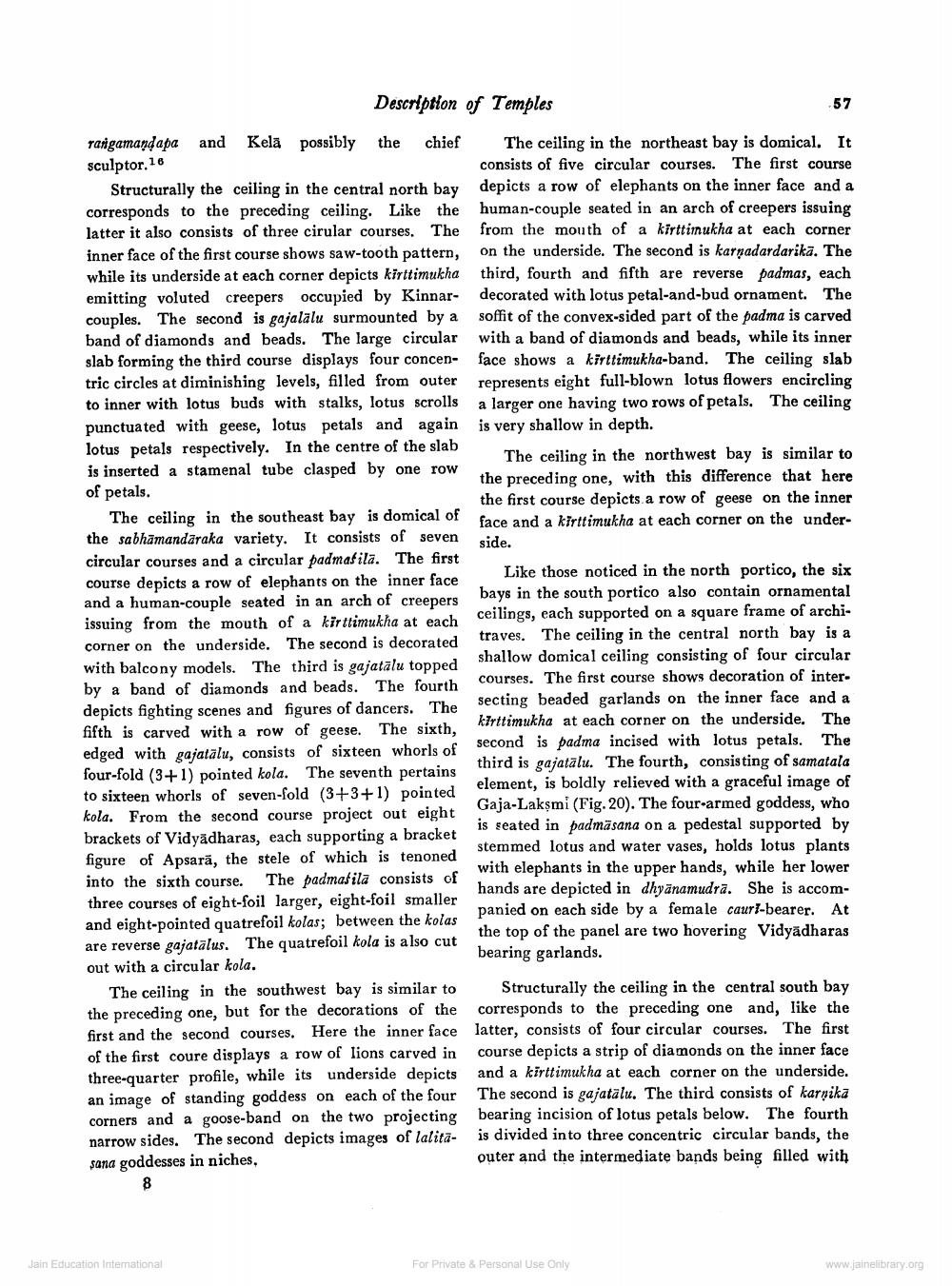________________
Description of Temples
57
rarigamandapa and Kela possibly the chief The ceiling in the northeast bay is domical. It sculptor. 16
consists of five circular courses. The first course Structurally the ceiling in the central north bay depicts a row of elephants on the inner face and a corresponds to the preceding ceiling. Like the human-couple seated in an arch of creepers issuing latter it also consists of three cirular courses. The from the mouth of a kirttimukha at each corner inner face of the first course shows saw-tooth pattern, on the underside. The second is karņadardarika. The while its underside at each corner depicts kirttimukha third, fourth and fifth are reverse padmas, each emitting voluted creepers occupied by Kinnar- decorated with lotus petal-and-bud ornament. The couples. The second is gajalālu surmounted by a soffit of the convex-sided part of the padma is carved band of diamonds and beads. The large circular with a band of diamonds and beads, while its inner slab forming the third course displays four concen- face shows a kirttimukha-band. The ceiling slab tric circles at diminishing levels, filled from outer represents eight full-blown lotus flowers encircling to inner with lotus buds with stalks, lotus scrolls a larger one having two rows of petals. The ceiling punctuated with geese, lotus petals and again is very shallow in depth. lotus petals respectively. In the centre of the slab
The ceiling in the northwest bay is similar to is inserted a stamenal tube clasped by one row
the preceding one, with this difference that here of petals.
the first course depicts a row of geese on the inner The ceiling in the southeast bay is domical of
face and a kirttimukha at each corner on the underthe sabhāmandāraka variety. It consists of seven
side. circular courses and a circular padmašila. The first course depicts a row of elephants on the inner face
Like those noticed in the north portico, the six and a human-couple seated in an arch of creepers
bays in the south portico also contain ornamental issuing from the mouth of a kürttimukha at each
ceilings, each supported on a square frame of archicorner on the underside. The second is decorated
traves. The ceiling in the central north bay is a with balcony models. The third is gajatalu topped
shallow domical ceiling consisting of four circular by a band of diamonds and beads. The fourth
courses. The first course shows decoration of interdepicts fighting scenes and figures of dancers. The
secting beaded garlands on the inner face and a fifth is carved with a row of geese. The sixth,
kirttimukha at each corner on the underside. The edged with gajatālu, consists of sixteen whorls of
second is padma incised with lotus petals. The four-fold (3+1) pointed kola. The seventh pertains
third is gajatālu. The fourth, consisting of samatala to sixteen whorls of seven-fold (3+3+1) pointed
element, is boldly relieved with a graceful image of kola. From the second course project out eight
Gaja-Lakşmi (Fig. 20). The four-armed goddess, who
is seated in padmasana on a pedestal supported by brackets of Vidyadharas, each supporting a bracket
stemmed lotus and water vases, holds lotus plants figure of Apsarā, the stele of which is tenoned
with elephants in the upper hands, while her lower into the sixth course. The padmašila consists of
hands are depicted in dhyānamudra. She is accomthree courses of eight-foil larger, eight-foil smaller
panied on each side by a female cauri-bearer. At and eight-pointed quatrefoil kolas; between the kolas
the top of the panel are two hovering Vidyadharas are reverse gajatālus. The quatrefoil kola is also cut
bearing garlands. out with a circular kola.
The ceiling in the southwest bay is similar to Structurally the ceiling in the central south bay the preceding one, but for the decorations of the corresponds to the preceding one and, like the first and the second courses. Here the inner face latter, consists of four circular courses. The first of the first coure displays a row of lions carved in course depicts a strip of diamonds on the inner face three-quarter profile, while its underside depicts and a kirttimukha at each corner on the underside. an image of standing goddess on each of the four The second is gajatalu. The third consists of karnika corners and a goose-band on the two projecting bearing incision of lotus petals below. The fourth narrow sides. The second depicts images of lalita- is divided into three concentric circular bands, the sana goddesses in niches,
outer and the intermediate bands being filled with
Jain Education International
For Private & Personal use only
www.jainelibrary.org




